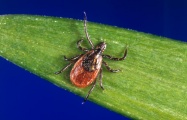Lyme Disease: Difference between revisions
Kevin Beale (talk | contribs) No edit summary |
Kevin Beale (talk | contribs) (/* === "Initially thought to be a disorder beginning in the skin and progressing to involve the joints, Lyme disease is now ranked as one of the great mimickers of other diseases, in a manner similar to that once ascribed to syphilis."<span class="fc) |
||
| Line 34: | Line 34: | ||
== Characteristics/Clinical Presentation == | == Characteristics/Clinical Presentation == | ||
==== | ==== | ||
Revision as of 22:20, 18 February 2010
Original Editors - Students from Bellarmine University's Pathophysiology of Complex Patient Problems project.
Lead Editors - Your name will be added here if you are a lead editor on this page. Read more.
Definition/Description[edit | edit source]

Lyme disease is an infectious disorder caused by the spiral spirochete bacterium Borrelia burgdorferi which is transmitted to humans though the bite of infected ticks in the genus Ixodes (commonly referred to as “black-legged” or “deer” ticks). The ticks that carry the disease are extremely small, generally not larger than 1 to 2 mm (see photo at left). Species of Borrelia capable of causing the disease occur regularly in the United States, Europe, Asia, and Australia.[1]
Prevalence[edit | edit source]
As of 2008, Lyme Disease ranked as the most commonly reported vector-borne illness in the United States. Between 1992 and 2006, 248,074 cases were reported in the United States including the District of Columbia and the U.S. territories. The number of cases reported annually increased 101% from 9,908 cases in 1992 to 19,931 in 2006, with 93% of those cases occurring in 10 states in New England and the Upper Midwest (Connecticut, Delaware, Massachusetts, Maryland, New Jersey, New York, Pennsylvania, Rhode Island, and Wisconsin).[2]
Rates of incidence have continued to rise since 2006, with 27,444 cases reported in 2007 and 28,921 cases in 2008. As of 2008, the rate of incidence was 9.4 cases per 100,000. Children 5 to 14 years of age have the highest rate of incidence with an average of 8.6 cases per 100,000 compared to 3.0 cases per 100,000 for people 20 to 24 and 7.8 cases per 100,000 for ages 55 to 59.[3] Most cases develop during the summer months of May and August when individuals are more likely to visit wooded areas for work or recreation.
Characteristics/Clinical Presentation[edit | edit source]
==[edit | edit source]
Erythema migrans
88% of patients develop a red skin rash that enlarges over time.[3] Many patients also report that their rash first presents with a bulls-eye pattern, with redness migrating outward concentrically from a dark central lesion bounded by a band of lighter color (see photo). This symptom generally occurs within a few days of infection, varies widely in severity or be absent altogether, and may or may not be accompanied by other symptoms.) The variability of this symptom, combined with often mild symptoms of the early stages of the disease contributes to the difficulty in early diagnosing.
Flu-like symptoms[1]
Fever, chills, fatigue, headache, and muscle or joint pain generally develop soon after infection (within several days) if they develop at all. In many cases, individuals who develop flu-like symptoms do not develop a rash. Thus, the presence of flu-like symptoms may represent the only clinical finding when a patient first presents.
Neurological symptoms[3], [1]
About 15% of patients experience neurological signs and symptoms. The most common presentation is that of aseptic meningitis (http://www.nlm.nih.gov/medlineplus/ency/article/000614.htm) or encephalitis with symptoms including headache, neck stiffness, Bell’s (facial) palsy (8% of patients), radiculopathies (4% of patients), and mild to moderate cognitive changes including an inability to concentrate, forgetfulness, and changes in behavior or personality.
Lyme Arthritis or general arthralgia
33% of patients develop Lyme-related arthritis, which causes swelling (usually unilaterally) in the large joints such as the knees. (CDC) Patients may also have myofascial or bone pain that moves over the course of hours or days.[1]
Cardiac symptoms
4 to 10% of patients present with cardiac signs and symptoms of varying severity such as tachycardia, bradycardia, arrhythmia, conduction block, or myocarditis.[1] Many patients with these findings may also report dizziness, shortness of air, and syncope.
Associated Co-morbidities[edit | edit source]
add text here
Medications[edit | edit source]
add text here
Diagnostic Tests/Lab Tests/Lab Values[edit | edit source]
add text here
Causes[edit | edit source]
add text here
Systemic Involvement[edit | edit source]
add text here
Medical Management (current best evidence)[edit | edit source]
add text here
Physical Therapy Management (current best evidence)[edit | edit source]
add text here
Alternative/Holistic Management (current best evidence)[edit | edit source]
add text here
Differential Diagnosis[edit | edit source]
add text here
Case Reports[edit | edit source]
add links to case studies here (case studies should be added on new pages using the case study template)
Resources
[edit | edit source]
add appropriate resources here
Recent Related Research (from Pubmed)[edit | edit source]
see tutorial on Adding PubMed Feed
Failed to load RSS feed from http://eutils.ncbi.nlm.nih.gov/entrez/eutils/erss.cgi?rss_guid=16koWIt7v5kGs5o9rzMBq36PwgOL9giIVWYvis28OMjhvAIogc|charset=UTF-8|short|max=10: Error parsing XML for RSS
References[edit | edit source]
see adding references tutorial.
- ↑ 1.0 1.1 1.2 1.3 1.4 Goodman CC, Fuller KS. Pathology: Implications for the Physical Therapist. 3rd ed. St. Louis, Missouri; Saunders Elsevier: 2009.
- ↑ Bacon RM, Kugeler KJ, Mead PS. Surveillance for Lyme Disease – United States, 1992-2006. CDC Morbidity and Mortality Weekly Report (MMWR) Surveillance Summaries. 2008; 57 (SS10): 1-9. Available at http://www.cdc.gov/mmwr/preview/mmwrhtml/ss5710a1.htm.
- ↑ 3.0 3.1 3.2 Lyme Disease. CDC Division of Vector-borne Infectious Diseases website. Available at http://www.cdc.gov/ncidod/dvbid/Lyme. Accessed February 18, 2010.






